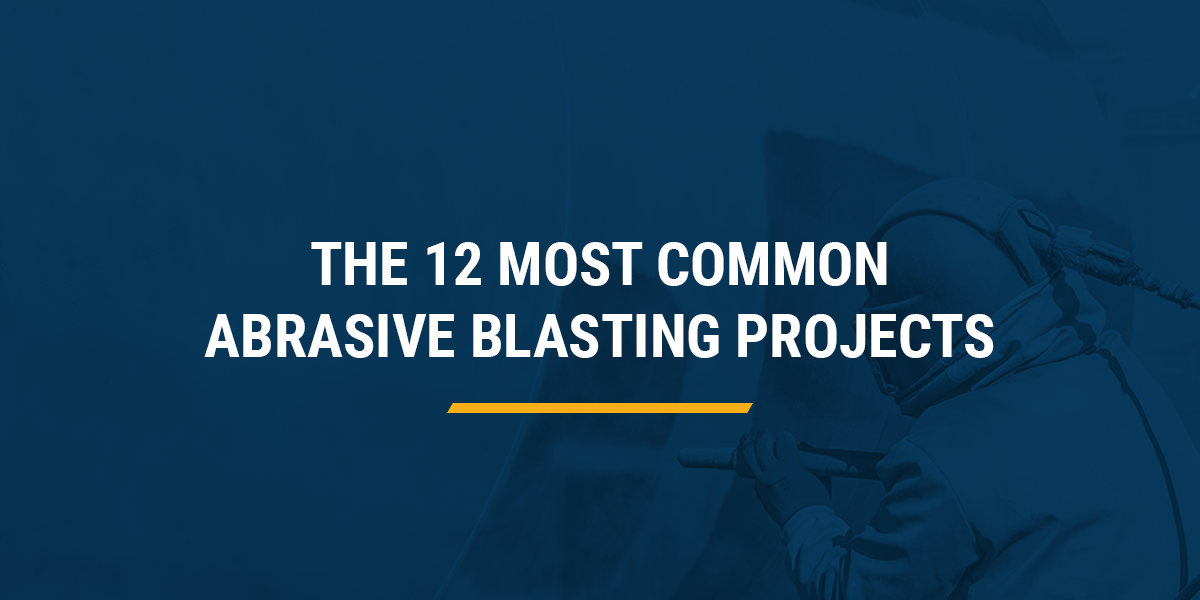14 Most Common Abrasive Blasting Projects

The 12 Most Common Abrasive Blasting Projects
May 09, 2023Abrasive blasting is a powerful and versatile technique used to clean, prepare, and maintain surfaces across a wide range of industries. Whether you're working with steel, concrete, wood, or even delicate materials like glass, abrasive blasting offers an efficient way to remove contaminants, smooth surfaces, and create a perfect base for coatings or finishes.
This method involves propelling abrasive materials at high speed onto a surface to clean, etch, or shape it. The type of abrasive used and the blasting method employed depend on the material being treated and the desired outcome. Common types include air blasting, wet blasting, vacuum blasting, and centrifugal blasting. Each has its own advantages, making them suitable for different applications, from industrial maintenance to architectural restoration.
Understanding when and how to use abrasive blasting can significantly improve efficiency, reduce damage risks, and support environmental sustainability. In this article, we’ll explore the 12 most common abrasive blasting projects that are widely used in both industrial and commercial settings.
Contact Us
1. Painting Preparation
Before applying paint, especially on metal surfaces like steel components, it's crucial to ensure the surface is clean and properly prepared. Abrasive blasting removes rust, old paint, and debris, creating a smooth and clean surface that enhances paint adhesion and durability. This step is essential for long-lasting results and preventing future corrosion.
2. Food Process Maintenance and Cleaning
In the food service industry, maintaining cleanliness is a top priority. Abrasive blasting, particularly with natural or organic media like dry ice, is ideal for cleaning stainless steel equipment, baking tools, and other surfaces that come into contact with food. It effectively removes baked-on residues without damaging the surface or leaving harmful chemicals behind.
3. Architectural Component Preparation
Architectural elements such as beams, columns, and decorative pieces often require precise surface preparation before coating or finishing. Abrasive blasting helps clean and smooth these surfaces, ensuring a uniform finish. It’s also commonly used in restoration projects, where careful removal of old layers is necessary without damaging the underlying structure.
4. Concrete and Wooden Surface Restoration
Concrete, wood, and brick surfaces can be restored using gentle abrasive blasting techniques. Materials like soda or dry ice are ideal for removing stains, paint, or old coatings without harming the original material. This method is cost-effective and preserves the integrity of the surface while preparing it for new finishes.
5. Warehousing Cleaning
Warehouses often have large structures and heavy machinery that accumulate dirt and residue over time. Dry and wet abrasive blasting can efficiently clean structural struts, joists, and equipment. Portable blasting systems allow for flexible cleaning, making it easier to target specific areas that need attention.
6. Railroad Car Maintenance
Railroad cars transport a variety of materials, and regular maintenance is essential to keep them in good condition. Abrasive blasting helps remove hazardous residues, old paint, and contaminants, ensuring the car remains safe and functional between shipments. It’s also a key step in preparing the car for repainting.
7. Bridge Maintenance
Bridges, especially those made of concrete or steel, require frequent cleaning and maintenance to prevent deterioration. Abrasive blasting is a fast and effective way to remove rust, old coatings, and grime. It ensures that critical components remain intact while allowing for proper painting or protective treatments.
8. Component Surface Preparation and Etching
For precision work, such as etching designs into glass or preparing surfaces for powder coating, abrasive blasting is an essential tool. Materials like silicon carbide offer a rougher, more aggressive blast, making them ideal for heavy-duty applications. This process ensures optimal bonding and surface quality for subsequent treatments.
9. Plastic Injection Mold Cleaning
Plastic injection molds can become clogged with hardened residues after repeated use. Abrasive blasting provides a gentle yet effective solution for cleaning these molds without damaging their delicate surfaces. It’s also useful for removing anti-corrosion coatings and deflashing plastic parts.
10. Casting Application Sanding
In foundries, sand-casting molds need regular cleaning and maintenance. Using materials like Starblast improves visibility and reduces labor costs. These abrasives provide consistent results and are ideal for tasks like paint removal and heavy rust cleanup.
11. Bearings, Shafts and Gears Lifetime Improvement
To extend the lifespan of machine components like bearings, shafts, and gears, abrasive blasting is used for shot peening. This controlled process strengthens the metal surface, improving its resistance to fatigue and wear, which is crucial for heavy-duty machinery.
12. Graffiti Removal
Graffiti removal is one of the most popular uses of abrasive blasting. Natural abrasives like corn cobs or walnut shells are preferred for their safety and effectiveness. They gently remove graffiti without damaging the underlying surface, making them ideal for public spaces and commercial properties.
Contact Finishing Systems to Learn More
Abrasive blasting is a valuable tool for cleaning, maintaining, and preparing surfaces across many industries. At Finishing Systems, we specialize in providing high-quality blasting solutions tailored to your needs. Whether you're looking for equipment, services, or expert advice, our team is here to help. Contact us today to find out how we can support your next blasting project.
Jiangsu Bailite Transmission Technology Co., Ltd , https://www.zsindustrialbelt.com